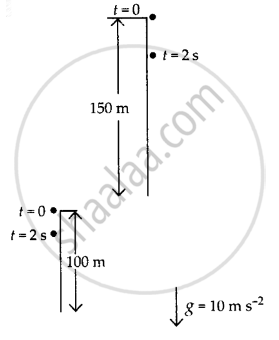Advertisements
Advertisements
Question
An object is dropped from rest at a height of 150 m and simultaneously another object is dropped from rest at a height of 100 m. What is the difference in their heights after 2s if both the objects drop with the same accelerations? How does the difference in heights vary with time?
Solution

Initially, the difference in heights of two objects
= 150 m – 100 m
= 50 m
Distance travelled by the first object in 2s
h = `"ut" + 1/2 "at"^2`
= `0 + 1/2 xx 10 xx 2 xx 2`
= 20 m
Distance travelled by the second object in 2s,
h' = `"ut" + 1/2 "at"^2`
= `0 + 1/2 xx 10 xx 2 xx 2`
= 20 m
Height of first object from ground at t = 2s
= 150 m − 20 m
= 130 m
Height of second object from ground t = 2s
= 100 m − 20 m
= 80 m
∴ Difference in height after t = 2s
= 130m − 80 m
= 50 m
The difference in heights does not vary with time as long as both the objects are in motion. However, when the second object reaches the ground and the first one is still in motion, then it decreases.
APPEARS IN
RELATED QUESTIONS
Which of the following is true for displacement?
- It cannot be zero.
- Its magnitude is greater than the distance travelled by the object.
Differentiate between distance and displacement.
From the displacement-time graph of a cyclist given below in the Figure, find The displacement from the initial position at the end of 10 s,

A body at rest is made to fall from the top of a tower. Its displacement at different instants is given in the following table:
| Time (in s) | 0.1 | 0.2 | 0.3 | 0.4 | 0.5 | 0.6 |
| Displacement (in m) | 0.05 | 0.20 | 0.45 | 0.80 | 1.25 | 1.80 |
Draw a displacement-time graph and state whether the motion is uniform or non-uniform?
A bird sitting on a wire, flies, circles around and comes back to its perch. Explain the total distance it traversed during its flight and its eventual displacement.
Draw displacement – time graph for the following situation:
When a body is moving with variable velocity.
A body is moving along a circular path of radius r. What will be the distance and displacement of the body when it completes:
Full revolution
A car travels at a uniform speed of 42 km/h. In 10 minutes, how much distance would it cover?
An object covers a distance of S meters in t seconds as follows :
| S (meters) | 0 | 8 | 20 | 20 | 16 | 10 | 0 |
| t (Seconds) | 80 | 2 | 5 | 10 | 12 | 15 | 10 |
Plot a graph, taking t on X-axis and S on Y-axis. Determine the velocity of the object at time
(i) 6 s, and
(ii) 14 s.
A quantity that has both magnitude and direction is ______.
